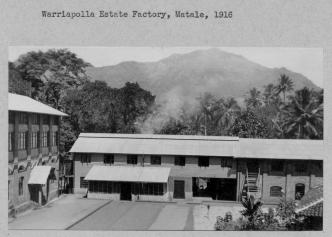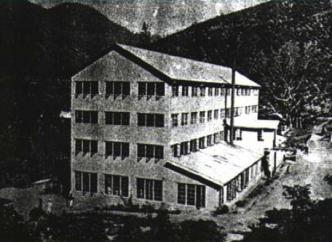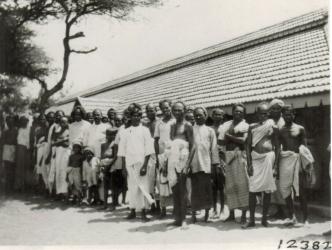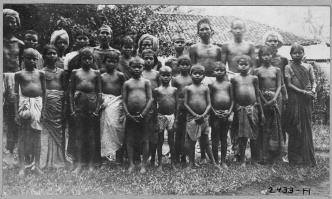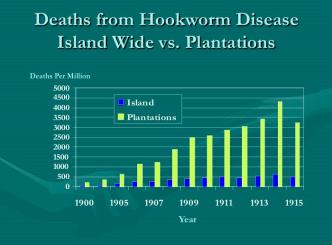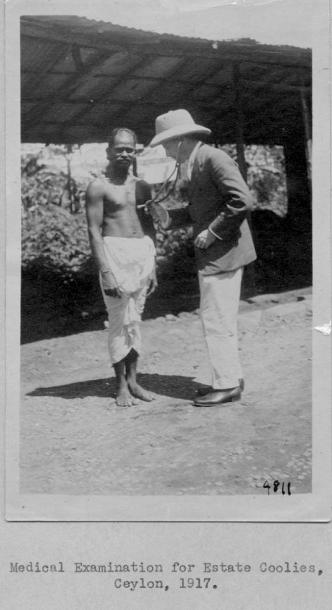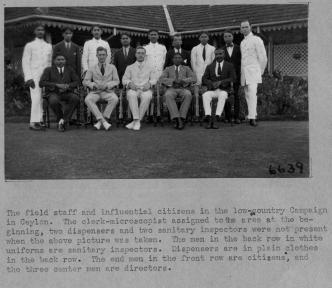Part 1 of a three part series on the history of Rockefeller engagement and the development of public health in Sri Lanka.
Before the Rockefeller Foundation was established in 1913, the Rockefeller Sanitary Commission for the Eradication of Hookworm Disease was working in the Southern United States to eradicate hookworm disease (ancyclostomiasis) in impoverished rural populations. When the Sanitary Commission was created in 1909, over 40% of the population in 11 Southern states harbored the parasite without any knowledge of the infection. This was because those afflicted with the parasites readily succumbed to secondary diseases, which were the most commonly attributed cause of death for hookworm sufferers. The Sanitary Commission combined medical treatments, public health education, and a campaign to install sanitary privies to prevent reinfection, eventually declaring success in controlling hookworm in the American South. It provided the foundation for the International Health Board’s worldwide program against the disease.
The establishment of the Rockefeller Foundation’s International Health Board (IHB) marked the beginning of Rockefeller philanthropies' global reach, which eventually came to encompass hookworm control in Sri Lanka. Under the leadership of Wickliffe Rose, a pioneer in public health, the IHB began its work by investigating worldwide incidence of hookworm disease. A great part of the more heavily infected areas of the world, described as “the great hookworm belt,” belonged to the British Empire, so Rose decided to begin the campaign in the British colonies and spheres of influence in the West Indies, Egypt, Malaya, and Ceylon (Sri Lanka).
When undertaking projects, the Foundation’s policy was to work in partnership with the authorities of the country in which it was involved. The policy of working through governments often proved to be difficult for the Foundation’s officers, especially in a colonial context. When the IHB first approached the colonial government and planters in Sri Lanka, for example, they strongly objected to the proposed plan to start a hookworm control campaign for fear that it would threaten existing social and economic relationships. However, Rockefeller representatives eventually convinced them that improved health would also mean increased productivity and reduced absenteeism.
Consequently, in 1916, the IHB inaugurated a hookworm control campaign on 24 plantations in Sri Lanka’s Matale district which had a population of about 10,000 South Indian immigrant workers. With the approval of the colonial government and the powerful Planters’ Association, IHB representatives J.E. Snodgrass, W.C. Sweet, and W.P. Jacocks developed a working plan for Sri Lanka. The planters agreed to build latrines on the plantations, and the government promised to provide technical assistance to the planters that would initiate improvements in sanitation. In addition, the campaign provided treatment for those infected, a study of suitable and affordable types of latrines for the estates, and an information campaign of the cause and prevention of hookworm disease done through lectures, distribution of pamphlets, and demonstrations.
In addition, estate pharmacists were trained to diagnose hookworm infection using microscopic and clinical techniques and to administer proper doses of chenopodium oil as treatment. By the end of 1917, the hookworm control program had treated about 40,000 people. The death rate declined from 13.8 per 1,000 to 7.5 per 1,000 after the hookworm control campaign. General health improved, and hospital admissions were reduced 27% between 1916 and 1918.
Sri Lanka became a British Crown colony (Ceylon) in 1815 when British troops conquered the Kandyan Kingdom of Sri Lanka. The war was so devastating that its bitterness remained in the minds of the Kandyan Sinhalese, who then refused to work for the British on their estates when the British established plantation industries in coffee, tea, and rubber during the mid-19th century. To meet the labor shortage, planters recruited workers from the nearby South Indian state of Tamil Nadu. By the end of the 19th century, about 100,000 immigrant laborers and their families arrived annually in Sri Lanka.
The periods of high levels of immigration coincided with the expansion of the plantation industries: coffee between 1841-1880, tea from 1890-1910, and rubber from 1900-1920. Workers came by boat to the northwest coast of Sri Lanka; from there they walked for about two weeks along hazardous jungle roads to the plantations in Sri Lanka’s central province. Workers faced the threat of malaria infection and often succumbed to disease, starvation, and exhaustion on their journey. Many of these laborers came from the lowest social strata of the Hindu caste hierarchy and were expected to undertake the most menial occupations in society for which they were intermittently and poorly paid. In migrating to Sri Lanka they simply exchanged their former situation for a similar one. These exploitative customs continued on the plantations in Sri Lanka under British colonial rule in what was effectively an indentured labor system.
As employers, the planters were required to provide accommodation and medical care for the workers. The workers lived in barrack-like “lines,” with as many as 12 people in an 8 by 10 ft. windowless room. The small verandas of the lines were used to keep goats, cattle, chickens, and other livestock, but these were often boarded up to keep out the drenching monsoon rains, a practice that also kept out much light. The lines had no latrines. As a result, the entire vicinity surrounding the lines became a repository of night-soil and household refuse.
The workers were paid on the basis of work units similar to that of piecework in factories. If they were in good physical condition, they could complete more units of work a day, and be paid accordingly. Less productive workers earned less. As a result of this arrangement, entire families often worked tirelessly to complete the assigned work units. Children started working in the fields as early as six years of age.
In the extremely unhealthy sanitary conditions on the plantations, the workers and their families encountered a wide range of parasitic and infectious diseases. Hookworm disease was one of the numerous infectious diseases among plantation laborers and was first reported in 1888 when 31 cases were diagnosed. By 1899, about 239 deaths from hookworm disease (Ancyclostomiasis) had been reported in Sri Lanka. Over 80% of the reported cases were immigrant workers, and the rest were people living in the villages of neighboring plantation areas. Sanitary conditions on the estates were so deplorable that only 17 years later the hookworm infection had reached epidemic proportions. By 1916, more than 90% of the population on the plantations was infected with the disease. In turn, the poor sanitary conditions caused the disease to spread rapidly into neighboring areas.
By 1894, health authorities had recognized that hookworm disease was widespread in Sri Lanka, mostly in provinces with immigrant labor. Authorities also believed that mortality from hookworm disease was understated because many hookworm sufferers were recorded as dying from diarrhea, dysentery, anemia, dropsy, debility, or fever. Hookworms are tiny parasites about one-half of an inch in length. Although parasitic in the bowel, the worms enter the human body through the pores of the skin when they come in contact with soil polluted by human excrement. Victims of hookworm infection suffer from undernutrition, anemia, and lassitude. Drained of normal levels of blood, hookworm sufferers are too weak to resist new infections, which in turn usually cause their deaths.
On this topic, Mary Boccaccio has written: "Hookworm rarely reaches epidemic proportions. It disables rather than kills, and weakens resistance so that susceptibility to other diseases is increased. A result of soil pollution, the parasite enters the body through the skin, usually around the toes, and causes a sore or irritation. Thus it has been called 'ground itch' or 'dew poison.' Once in the body it travels in the bloodstream until it reaches the intestines where it can live on man's blood for over ten years. Eggs are passed from the body and hatched in moist and sandy soils, beginning the cycle over again. It is easily and inexpensively cured, and prevented through proper soil sanitation."
In 1909, upon a recommendation by a British Medical Associate committee—concerned with hookworm infection as a common health problem in many of the British colonies— the Secretary of State for the Colonies wrote to the Governor of Sri Lanka regarding the high death toll among immigrant workers. The letter described the economic loss for the planters resulting from the ill health of the workers, and the fact that it could be avoided with inexpensive measures. However, the Secretary of State had an inadequate understanding of plantations’ labor recruitment practices and the government’s laissez-faire policy towards these practices. Because the government had adopted a policy of non-intervention in business affairs, the official viewpoint was that hookworm disease was the planters’ problem to solve. But the planters did not understand the direct relationship between a healthy labor force and economic productivity and, hence, any economic benefit from controlling and curing the disease.
Labor was acquired for the plantations from neighboring India by the planters themselves or by estates’ agents, known as “Kanganies,” who recruited workers in India and acted as leaders of groups of up to 100 workers. Kanganies took the workers to Sri Lanka, supervised their work on the plantations, and received kickbacks for productive workers. Each Kangany also acted as mediator between the workers and the estate management. Direct control of the laborers led to widespread exploitation and abuse. With a seemingly endless supply of immigrant laborers, as a large number of workers continued to arrive in Sri Lanka each year, the large European firms that ran the plantations seemed unfazed by the high death toll and ill health on the plantations. Concerned with maximizing their profits, they ignored even the most basic sanitary requirements for the workers, such as the construction of latrines. Moreover, to justify their inaction, the planters even went so far as to assert that the workers would not use sanitary facilities even if they were provided.
With short-term economic interests guiding British colonial labor policy in Sri Lanka, the epidemic of hookworm disease on the plantations and in neighboring villages spread, and neither the planters nor the government adequately acted upon the hookworm problem. This indifference persisted until 1916 when the Rockefeller Foundation’s International Health Board (IHB) started conducting hookworm treatment programs on a selected group of plantation estates. Victor Heiser, IHB’s director for Asia, was able to convince the government and planters that keeping laborers healthy was economical and to allow for intervention by American philanthropic organizations. With the IHB funds bearing more than half the cost, the project was implemented.
In spite of the improvements in the health of the workers, the Rockefeller program failed to eradicate hookworm disease on the plantations. The planters, with a ready supply of workers from India, did not perceive a relationship between their own profits and the health of the colonial labor force and, therefore, did not fully cooperate with the program. The planters did not undertake the major sanitary reforms suggested by the IHB. At the beginning of the campaign, they agreed to construct latrines, but they did not honor this commitment, so the government (pressured by the IHB) introduced legislation making it compulsory for all the estates to provide sufficient latrines for the workers’ lines. To comply, many estates constructed shoddy latrines using temporary materials such as cadjan and jute bagging which did not last more than a few weeks. The government did not step in to enforce its requirements. Therefore, persistent soil pollution on the plantations contributed to a high rate of re-infection. Together, the planters and the government’s policy of non-interference prevented effective control of hookworm disease on the plantations.
In 1919, 3 years after the completion of treatment in Matale district, an IHB examination of a sample of workers showed a high rate of re-infection among those who had been cured in 1917. On 33 estates in the district, the average rate of re-infection was 88%, while the level of re-infection ranged from 45% to 100%. Faced with this situation, the government took no significant action. The hookworm control campaign on the plantations failed to achieve its goal because sanitary conditions were not improved while treatments were being carried out. The continued soil pollution on the estates and in the neighboring villages created a cycle of re-infection, which prevented total eradication of the disease. With the planters and the government willing to allow IHB medical personnel to treat the workers, but unwilling to expend capital to improve sanitary conditions, the hookworm control program came to an abrupt end.
The IHB’s position as mediator between the government and the planters compromised its position to advocate sanitary reforms more forcefully. And although the IHB was concerned with the prevention the disease, for their part, they were successful in their attempts to cure the disease with medical treatment and in demonstrating the curative power of Western medicine. The irony is not lost that the money spent on treatment could have easily provided a sufficient number of latrines on the plantations.
Dr. Heiser’s report on IHB's decision to stop the campaign expressed disappointment with the level of cooperation of the government and the planters. By the end of 1922, the IHB had spent around $200,000 on the hookworm control campaign in Sri Lanka, given demonstrations on approximately 1700 estates, and had treated a total of 413,175 individuals on the estates and neighboring villages, sometimes treating a single person up to 4 times. But the IHB could neither reduce nor eradicate hookworm infection on the plantations because they could not prevent continued re-infection. After 6 years of hookworm treatment, the IHB decided to stop its work on the plantations after 1922, based on the assessment that without the estates putting forth efforts to improve sanitation, it would be futile to continue treatment activities on the plantations. Instead, Dr. Jacocks advised that the emphasis should be shifted from hookworm control on the estates to a comprehensive health program, which would include hookworm control, sanitation and other related problems, directed toward native communities on the island.
Boccaccio, Mary. 1972. "Ground Itch and Dew Poison: the Rockefeller Sanitary Commission 1909-14." Journal of the History of Medicine and Allied Sciences 27: 30-53.
Hewa, Soma. 2008. “Medicine and Colonialism in Sri Lanka.” In Encyclopaedia of the History of Science, Technology, and Medicine in Non-Western Cultures, edited by Helaine Selin, 1475-1482. Springer, New York.
Hewa, Soma. 1995. Colonialism, Tropical Disease and Imperial Medicine: Rockefeller Philanthropy in Sri Lanka. Lanham, MD: University Press of America.
Hewa, Soma. 1994. "The Hookworm Epidemic on the Plantations in Colonial Sri Lanka." Medical History 38 (No. 1): 73-90.
Hewa, Soma. 1993. “Rockefeller Philanthropy and the Development of Public Health in Sri Lanka.” Research Reports (Spring).
Hewa, Soma. n.d. "Colonial Labor, Rockefeller Philanthropy, and the Development of Public Health in Sri Lanka: From 'Model Colony' of the British Raj to 'Crown Jewel' of the Rockefeller Foundation." (Unpublished research paper)

